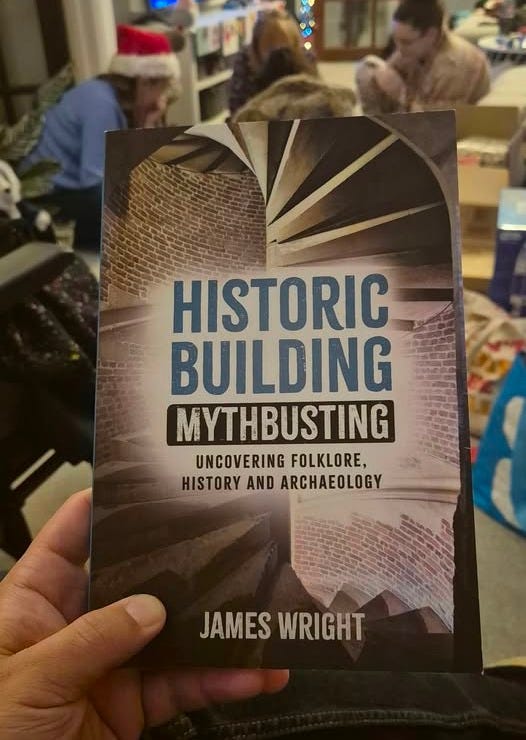Book Review: 'Historic Building Mythbusting' by James Wright
A factual investigation that brims with authority whilst enormously enlightening and entertaining
On reflection, as I begin this review, I find is surprising it has taken so long for an intrepid medievalist mythbuster to step forward and wage an informed and intellectual war on much of the drivel that has taken root across the generations regarding our historic built environment. It is to be lamented we exist in an age rife with anti-expertism and post-truth, but fortunately, for the integrity of medieval studies at least, Dr James Wright has had enough.
Historic Building Mythbusting: Uncovering Folklore, History and Archaeology may very well be a project of passion, the sound culmination of two decades of experience at the forefront of building archaeology, but it serves as a vital rebuttal to the growing proliferation of specious storytelling about our past, increasingly promulgated by social media and swallowed by the masses without critical analysis of the subject matter. In short, this is a necessary study that should be widely read.
Wright outlines his objective at the outset, opening with three simple words that underpin the entire work – ‘historic buildings matter’, particularly for the authentic human stories associated with them. He intends to explore and debunk the popular myths that abound in discussion around these buildings but not in a ‘high-handed, condescending, or patronising tone’. He succeeds.
Any self-respecting book on the medieval buildings must begin with the most visible surviving remnants we have, the castle, with Wright exploring secret tunnels before embarking on a discussion about what purpose castles actually served, which in itself is often misunderstood. Particular attention thereafter is paid to spiral staircases and the idea they were a defensive feature designed to hamper right-handed invaders, the deconstruction of which the author has developed much of his public reputation around.
Contrary to the myth which has taken hold in recent times, these were not constructed exclusively clockwise, as Wright proves in excruciating detail, employing historical source material and on-location case studies to justify his argument.
They were, at their very essence, ‘an inherently elegant solution to accessing upper floors without surrendering a significant part of a building’s footprint’, and this required both clockwise and anti-clockwise solutions. What is more, Wright takes the effort not just to prove the myth wrong, but to explore precisely how the myth took hold in the popular imagination, even reasonably tracing its origin to one early twentieth century figure.
This is the template Wright takes to each of the myths that he explores in the book, recounting what the myth is, considering its viability, discusses historical scepticism before embarking on his reasonable disclosure of the likely the truth where appropriate. Finally, he respectfully if occasionally with barely concealed exasperation evaluates how the myth came to be.
It would be remiss of this review to reveal Wright’s conclusions on each matter discussed within, but suffice to say he covers matters like arrow sharpening in the churchyard, devil doors, leper squints, stonemasons marks, burn marks, recycled ship timbers, and finally, everyone’s favourite discussion over a pint, Britain’s oldest pub – to learn more about each subject, including his evaluation of each pub’s claim, you’ll have to buy the book, I’m afraid.
But contrary to an outpouring of ‘evidence’ such as a painted sign on the pub’s exterior, it’s categorically not Ye Olde Trip Jerusalem in Nottingham which fails to stand up to Wright’s eagle-eyed scrutiny, as do many other inns that profess to be 800 years old. As the author notes, ‘Sadly, there are no pubs that can provide genuine archaeological or archival evidence to demonstrate that they have a linear chronology stretching back into the early medieval period’.
If you’re enjoying a pint in pub that claims to be 10th century, alarms should be ringing, particularly if they likewise claim to be made from shipwrecked timbers retrieved from the ill-fated Spanish Armada.
With each subject discussed, Wright employs strict historical logic together with advancements in science to come to his compelling conclusions. Though a deep dive into archaeological jargon may be daunting, throughout the accessible study Wright litters his writing with an abundance of personal anecdotes and insights that blends his expertise with humour. He strikes the balance perfectly.
I would implore anyone to read to this work, not just someone intrigued in the medieval world. This is factual investigation that brims with authority, whilst being enormously enlightening and entertaining. And as Wright is at pains to convey to his reader throughout, ‘our history underpins who we are’ as it ‘forms attitudes in the present and shapes decisions made for the future’. We have all have a duty to respect those that came before, and the buildings they lived and worshipped in.






Great review! I’m looking forward to the talk James will give on this very subject at Harvington Hall History Festival in July. And I can’t wait for your talk either, Nathen 🙂.
Sounds wonderful!
I never believe everything I hear from tour guides anywhere. My favourite British castle tour was quite clear about what was 12c, what was 17/18c, and what was Victorian.
Regards to your admirable feline.